
If you've ever dreamt of wandering through the endless dunes of the Sahara, surrounded by music, dance, and a feeling of timeless tradition, then the desert festivals Algeria celebrates are your perfect escape. Far from ordinary tourist trails, these vibrant gatherings are living museums of nomadic life-a window into how communities in the desert express joy, unity, and faith through art, ritual, and hospitality.
In recent years, cultural tourism in Algeria has quietly become one of North Africa's most rewarding experiences. From the famous Tuareg festivals at Djanet and Tamanrasset to local desert celebrations at Timimoun, visitors discover how the southern Algeria traditions come alive under the Saharan sun.
More than 80 percent of Algeria falls within the Sahara Desert, yet only a few travelers venture into its south. Here, in this vast landscape, lie some of the oldest and most authentic Sahara cultural events, where time-honored rituals still guide daily life.
In Algeria, the desert festivals are not seasonal parties; they are an essential expression of community identity. They celebrate the bond between people and the desert: the sand, the stars, the oases, the long caravan routes that over the centuries shaped life here.
For visitors from the U.S., this desert celebration means immersion into a world where ancestral customs are not maintained behind glass but lived and breathed every day. In all, dances, costumes, music, and storytelling make up the tapestry of resilience and beauty known to southern Algeria's traditions.
The most captivating desert festivals of Algeria are by Tuareg; they unveil the rich heritage of the "Blue People" of the Sahara: in their indigo-robed finery, with nomadic elegance and poise, Algeria's Tuareg retain an identity all their own through ceremonial events that meld ritual, history, and collective memory.
Perhaps the most famous of all the Tuareg festivals, the Sebiba Festival is held once a year in the oasis town of Djanet.
The Sebiba Festival is a fine example of how Sahara cultural events have stood the test of time. For any traveler in search of authenticity, this is one of the unforgettable desert celebrations found in Africa.
Further west, right in the heart of the Hoggar Mountains, stands the city of Tamanrasset, where the Tin Hinan Festival is prominent among traditions in southern Algeria. In this festival, homage is paid to Queen Tin Hinan, a legendary matriarch among the Tuareg people.
Going on a visit to Tin Hinan is not tourism; it is to enter the living mythology of the Sahara, which even today inspires people, both locals and travelers, in search of real cultural tourism experiences in Algeria.
While Djanet and Tamanrasset capture the ancient essence of Tuareg life, Timimoun — also called the “Red Oasis” for its striking clay architecture — hosts a newer yet equally engaging event: the International Saharan Tourism Festival.
The development of this festival of ecotourism comes in line with growing interest in responsible travel; hence, it will also be a key event for cultural tourism in Algeria.

What sets these Sahara cultural events apart is the spirit that pervades all of them. Desert life has always been an ordeal — with little to go around, and with large expanses — but these festivals show another face of the desert: a place of abundance, generosity, and merriment.
These Saharan festivals are spiritual and social anchors for locals, who celebrate the passage of seasons, rejoicing in harvests as kinship is strengthened. For the travelers, they offer a seldom-experienced sense of belonging. Even as a visitor, you're welcomed into the celebration, sharing tea, food, and stories under the blanket of Saharan stars.
Visitors to Djanet, for instance, usually stay with locals or in desert camps where they share Tuareg music and folklore with their hosts. It's that level of openness that makes Algeria's desert festivals really special; they're participatory, not performative.
The festivals of southern Algeria are the living expressions of an old, yet adaptable culture, a perfect manifestation of patience, honor, and hospitality — essential qualities in order to survive in such an unforgiving desert environment.
For visiting Americans, attending desert festivals in Algeria takes some preparation, but it is well worth the once-in-a-lifetime experience.
Most cultural events in Sahara occur during the months of October and March when the temperatures are moderate. The Sebiba Festival also corresponds to the Islamic New Year, while the Timimoun festival usually takes place at the start of winter.
Fly first into Algiers, from where domestic airlines take you onward to southern cities such as Tamanrasset, Djanet, or Timimoun. Still, road journeys are very long, but with surprisingly scenic routes, passing through mountain chains, oases, and dunes, setting the stage for festivals in the desert.
Options range from guesthouses in oasis towns to desert luxury camps. Most of the festivals also offer community homestays, which immerse the visitor right into the traditions of southern Algeria.
Attention should be paid: dress modestly, ask for permission before taking pictures, and participate humbly. The Tuareg people are known to be very hospitable, but they do appreciate honesty and respect for their customs.
Responsible tourism in Algeria begins with minimizing the environmental impacts, particularly by sticking to marked paths in dune areas, supporting local artisans, and using guides from the local community who return money to their communities.
These desert festivals may have their origins in ancient customs, but they continue to hold relevance even in modern-day Algeria.
For the traveling American seeking authentic, enriching experiences, Desert Festivals Algeria offers access to a culture still shaped by the land itself.
The desert festivals are not entertainment; they are living testimony to hard-won endurance and creativity.
Every festival, from the very traditional Tuareg festivals to modern tourism-embracing Sahara cultural events, is a dialogue of past and future. They remind one that culture, much like the shifting dunes of Sahara, is never at rest; it evolves, dances, and adapts.
For those who travel south to witness these desert celebrations, the reward lies not in the beauty of the performances or the grandeur of the desert but in the warmth of its people. With Algeria's continuous growth in cultural tourism, these events have come to stand as strong symbols of authenticity, a testimony that even in the vast silence of the Sahara, the human spirit does sing
This content was created by AI